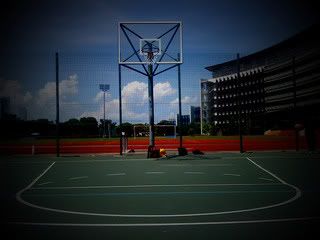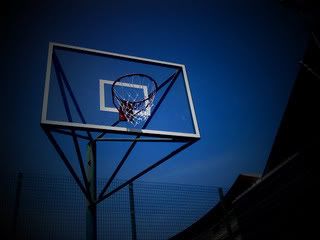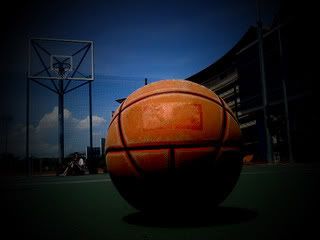a flat, rectangular surface with baskets at opposite ends (or in the case of 3-on-3 street basketball, half a court with one basket).
Competitive levels require the use of more equipment such as clocks, scoresheets, scoreboard(s), alternating
possession arrows, and whistle-operated stop-clock systems.
An outdoor basketball net.

A regulation basketball court in international games is 28 by 15 meters (approx. 92 by 49 ft) and in the NBA
is 94 by 50 feet (29 by 15 m). Most courts are made of wood, usually maple. A steel basket with net and backboard hang over each end of the court. At almost all levels of competition, the top of the rim is exactly 10 feet (3.05 m) above the court and 4 feet (1.2 m) inside the baseline. While variation is possible in the dimensions of the court and backboard, it is considered important for the basket to be of the correct height; a rim that is off by but a few inches can have an adverse effect on shooting.

There are also regulations on the size a basketball should be.
If women are playing, the official basketball
size is 28.5" in circumference (size 6) and a weight of 20 oz.
For men, the official ball is 29.5" in circumference (size 7) and weighs 22 oz.

Development of equipment and technique
Basketball was originally played with a soccer ball. The first balls made specifically for basketball
were brown, and it was only in the late 1950s that Tony Hinkle, searching for a ball that would be more
visible to players and spectators alike, introduced the orange ball that is now in common use.
Dribbling was not part of the original game except for the "bounce pass" to teammates. Passing the ball
was the primary means of ball movement. Dribbling was eventually introduced but limited by the
asymmetric shape of early balls. Dribbling only became a major part of the game around the 1950s, as
manufacturing improved the ball shape.


No comments:
Post a Comment